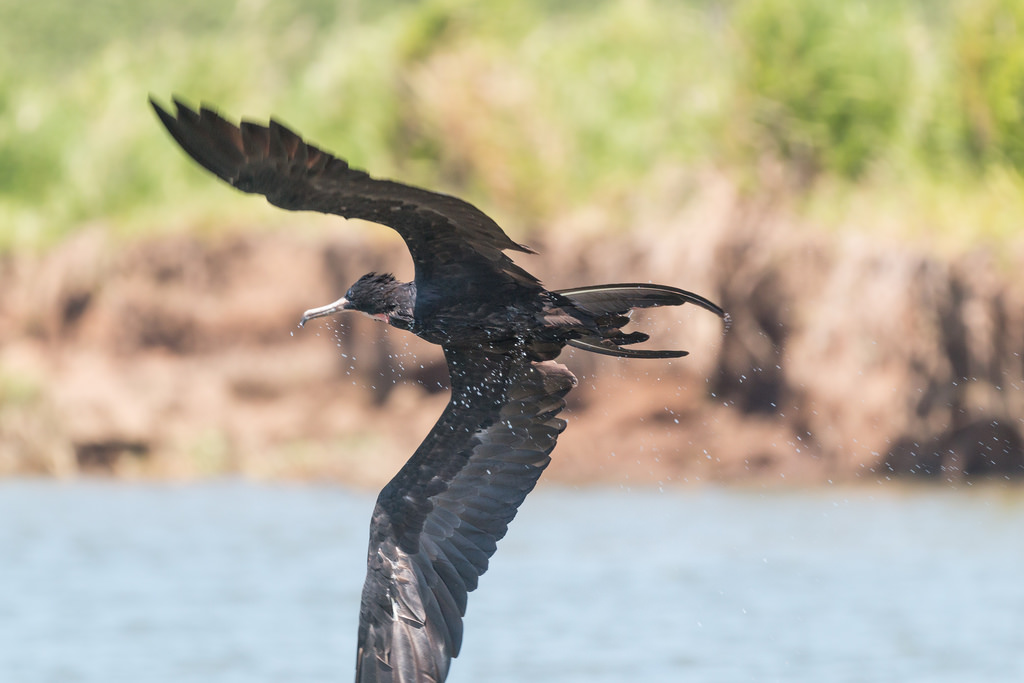Don’t Miss Costa Rica’s Amazing Wildlife!

From the screeching Scarlet Macaws preparing to fly each day at 3:00 p.m. along the pristine black sand beaches of the warm Pacific Ocean to the hundreds of crocodiles basking in the sun on the banks of the Tarcoles River, Costa Rica has some amazing diverse exotic wildlife. As a visitor here, your vacation goals may include soaking up some rays on one of the many beautiful beaches on either the Pacific Ocean or the Caribbean Sea, or taking a surfing lesson, but be sure to include a nature tour during your stay.
Our family was fortunate enough to take in three tours based from our stay in the central Pacific area of Costa Rica, near the resort city of Jaco. Our hosts Dave and Shannon recommended these tours. Their website is www.Ecovidaproperties.com.
Rafa’s Tour, ‘The Father of the Monkeys’, as Rafa likes to refer to himself, took our group exclusively, to the Damas Island Estuary, near the town of Quepos. Rafa, his son, who was driving the flat-bottomed fiberglass boat, and his grandson David ferried us around the estuary. Along our way we observed blue herons; white Ibis, lizards, etc., sitting on the branches or standing on the shore. As we slipped into a narrow mangrove lined canal, Rafa stood at the bow of the boat, cupped his hands around his mouth and uttered a strange calling sound. After several minutes of repeating the call, suddenly, white-faced monkeys appeared from the dense deciduous trees growing near the waters edge. More and more monkeys arrived, first bouncing on the top of the watercraft’s canopy and then climbing aboard. Rafa placed over ripe banana mush into each of our hands to feed them. The monkeys would first glanced at Rafa, as if to ask his permission if it was all right to take the banana from our hands. Eventually, the monkeys, along with a couple of females who had young clinging onto their backs, became bolder and climbed on our shoulders and heads to get the banana bits. Rafa encouraged the monkeys to come and take more bananas as he continued to plop more banana mush in our hands.
Rafa, now 65 years old, has been taking visitors on this tour for 30 years now. For the last few years he is conducting these tours on his own without the partnership he previously had with the hotels.Rafa is teaching his son and grandson his skills of the trade so that they can take over the tours one day.
As the monkeys disappear into the jungle as quickly as they had appeared, Rafa emphasizes that the bananas we are feeding these monkeys, is only a dessert for them. They are omnivores and they forage from the forest floor to the canopy. Their natural diet consists of insects, flowers and sometimes lizards, bird’s eggs and nesting squirrels.
We continue on our journey and Rafa directs his son to stop the boat at the base of a bank with a large tree clinging to it. He scrambles up the bank and disappears over the rise. A short while later he returns, boards the boat with part of a termite nest in his hand. Rafa licks the tiny ant like insects and comments that they taste like strong coffee. He swears that eating termites are a great aphrodisiac and keeps him young. Rafa encourages us to try them. He then offers Jim and I a few termites to eat. I hesitate at first and then lick up a few of the tiny red insects, and yes, Rafa is right! They do taste similar to strong coffee!
As we make our way across the estuary back to the dock, I speak with David, Rafa’s 17-year-old grandson. He was weaving grasshoppers, angelfish and a boat from banana leaves for our granddaughter Rayn and grandson Phoenix. After David finishes high school his plan is to become a criminologist. I wish him well in his future plans.
The boat docks at the same spot we left from, beside the boats from the other tour companies. We thanked Rafa, his son and grandson for the delightful and educational tour and promised to tell others about this unique experience. To contact Rafa Tours, phone 2774-0261 or his cellular phone number at 8825-7808. Rafa answers the phone in a rather terse abrupt manner, but in person he is quite talkative. There is no website for Rafa Tours and payment for the tour is cash only.
Two days later we booked a crocodile tour on the Tarcoles River. Jose’s Crocodile River Tour was the company that Dave and Shannon recommended to us. Our driver Fernan drove our group to the dock where we met our jovial tour guide and owner, Jose Chaves. This time we would be riding in a larger boat with other tourists. Before we walked down the gangplank to board our boat, I spoke with a young couple from Zurich, Switzerland practicing the little German I knew.
We waited on our vessel for another group that arrived late, before motoring up the river. Jose filled us in on some facts about the 300 or so crocodiles that reside along the Tarcoles River, the fifth largest in Costa Rica.
One of the largest crocodiles is an 80 year old male, named Tornado, that measures 18 feet long. Jose entertained our group with humorous commentary and he beached our craft numerous times while his willing assistant grabbed large chunks of chicken from the cooler, jumped off thew boat and taunted the crocs by suspending the meat over their heads. They lunged up out of the murky water to devour them with one snap of their huge jaws. These reptiles are territorial and have names like Mike Tyson, Monica Lewinski, etc.
We traveled as far up the river until the water became too shallow, before turning around and heading west to the brackish water near the ocean. Along the way we took in the beautiful mountainous scenery of Costa Rica, passed various large farms that grew sugar cane and other crops, had cattle grazing near the steep bank, observed the white Egrets, white and blue herons on the shore, as well as a single yellow falcon. Jose took us into a narrow mangrove where we observed a baby crocodile hanging motionless on a branch. A pair of pink Roseate Spoonbills, not a common site, was perched on a tree near the mangrove canal.
We thoroughly enjoyed our tour with Jose and his crew. A number of locals and visitors have taken Jose’s tour a second or even a third time because they enjoy it so much. Jose shares a wealth of information about his beloved crocodiles in an entertaining manner that is sure to please all visitors. Again, cash only is accepted for payment for Jose’s Crocodile River Tour. You can reach Jose by cellular phone (506) 8874-7641 or 8325-6533 or check out his website at www.crocodilerivertour.com.
The next day Fernan picked up our group in his van and we drove south to Manuel Antonio National Park, just south of Quepos. The park admission is $10.00 U.S. per person. You may walk the pathways of the park on your own, but you will miss a lot of what nature has to offer here. There are so many unusual plants, insects, reptiles and animals here, that it takes a trained eye and a powerful telescope or pair of binoculars to see them. For that reason it makes sense to hire a naturalist guide to show you all the amazing things you will see in this beautiful park.
Our guide for the day was an affable and passionate local, whose name was Dagaberto Mora. We met him near the entrance to the park and the first thing he told us was that his sister would prepare a Costa Rica burrito and fruit salad lunch for us that would be ready for us at the end of our tour. This was an extra cost, but well worth it. Before we entered the park, Daga, as he likes to be called, stooped down and pointed out a small green plant, called Mimosa Pudica, with stems lined with rows of fine multiple leaves. He touched the leaves and they shrank back as if they had wilted. “This plant has a defense mechanism to protect it from being eaten by cattle, horses and other herbivores.” Daga commented. “Because of its sensitive nature of shrinking when being touched, it saves itself from being eaten!”
Daga took his time to explain the various indigenous flora and fauna native to the park. We would have missed the walking stick insect that blended in with the plants and on occasion we stopped to look through his telescope at interesting animals high up in the trees, like two toed sloths. He informed us that they eat the shoots and leaves of the trees they cling to, sleep for long periods of time and come down to the ground to defecate once a week.
We strolled slowly down the narrow pathway, passing other tour groups along the way. Mr. Mora took the time to explain about the various trees, vines and plant life that are indigenous to Manuel Antonio National Park. At one point, he saw a very poisonous snake and allowed each of us in turn to view and take a photo of it. He was happy that we could see this rare find.
Near the end of the tour we saw squirrel monkeys and white-faced monkeys swinging through the trees parallel to us as we walked along. Perhaps they were hoping to be fed, which is against park rules.
Our tour ended at a beautiful sheltered cove, referred to as beach #3. Daga’s sister was there with our delicious burrito and mixed fruit salad lunch already spread out on one of the picnic tables. We were cautioned to protect our food, as resident raccoons will rush in to steal and run away with any unprotected morsels.
After lunch we changed into our swimsuits at the nearby clean change rooms and went for a nice swim in the safe bay. It was a nice cap to another beautiful day.
This nature tour is another cash only tour. Dagaberto Mora can be contacted by telephone at 2777 0896 or 8858 0689 if you are in Costa Rica, or his E-mail is naturelovertours@gmail.com. Note that if you have smaller children, around 4 years old, Daga, who has a young son, will connect with them to make it interesting for them.
There you have it, three great tours to see on the central Pacific coast, all within a short drive from each other. Lastly, to get around, I highly recommend Fernan Valverde and his taxi service and tour transfers. He speaks great English and can be reached at (506) 8865 2828 on his cellular phone or E-mail: fvalverde35@gmail.com. Pura Vida!




